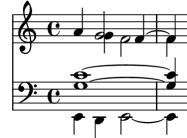

- #LILYPOND TIES AND CHORDS HOW TO#
- #LILYPOND TIES AND CHORDS PRO#
- #LILYPOND TIES AND CHORDS CODE#
- #LILYPOND TIES AND CHORDS FREE#
This eliminates the is and es for sharps and flats, using instead s and f, which I find more intuitive. I have also found it much easier to input music using \include english.ly. In most of our templates, for example, we use a \transpose line (comment it or not), which allows us to compose any song in the Key of C, and then transpose the output to any key desired. I and a friend made a few templates that were useful to us as primarily hymn writers, and the process of composing in Lilypond was profoundly simplified. Lilypond is a powerful engine all you need is a well-appointed operators’ cockpit from which to control it. Years ago, I tried and gave up on Lilypond probably 3 times before I discovered Lilypond Tool (a jEdit extension), and then Frescobaldi to use as frontends.
#LILYPOND TIES AND CHORDS CODE#
This is a LilyPond editor, which highlights bits of code in different colors, shows you exactly where your errors are located, and shows the score on the side (you do need to save and recompile to see changes). One last quick recommendation: Frescobaldi. But when you make parts, the lower parts won’t have these markings. On a score, you could add tempo markings to the top staff, and it will look fine. Where I usually run into trouble is taking out measures and adding text across all instruments. I tend to print out that draft, mark it up in red pen, then enter my edits. I always sketch by pencil beforehand, then enter the notes all at once. Writing directly in LilyPond would be a pain. Ties are ~ and slurs are ( ) LilyPond is for engraving, not for composing Articulations are a hyphen and a similar glyph. Natural notes are just their letter names. I think I’m just as fast typing in notes by text than I was when I typed in notes on Sibelius. That may sound cumbersome, but it’s not, necessarily. You can’t click on a staff and make a note. Let me reiterate: LilyPond is a markup language, so it works very differently than Finale, Sibelius, Dorico, MuseScore, etc. (Say hi in the comments if you use LilyPond!) How do you use LilyPond?

I hear less and less about Lilypond these days I think it’s mainly used by computer geeks who dabble in composition, rather than composers who dabble in computer geekery.
#LILYPOND TIES AND CHORDS FREE#
The visual appearance is the selling-point for this free software. This is less of a “notation program” than a “markup language” like HTML or LaTeX, and it creates really beautiful-looking music. In 2012 or so, I went really contrarian and started using the free platform LilyPond.
#LILYPOND TIES AND CHORDS HOW TO#
Yet, I’ve taught students how to use Finale several times… A software contrarian I felt that Sibelius was more intuitive than Finale, and stuck with that. I’ve been a contrarian in these “debates” (scare quotes fully intentional). The original Sibelius team moved on to create Dorico, which seems to be a popular growing upstart.

#LILYPOND TIES AND CHORDS PRO#
Now that Sibelius has been incorporated into AVID (which owns Pro Tools and other programs), I see the name less. Doricoįor many years, one of the main “debates” for composers was Finale vs.


 0 kommentar(er)
0 kommentar(er)
